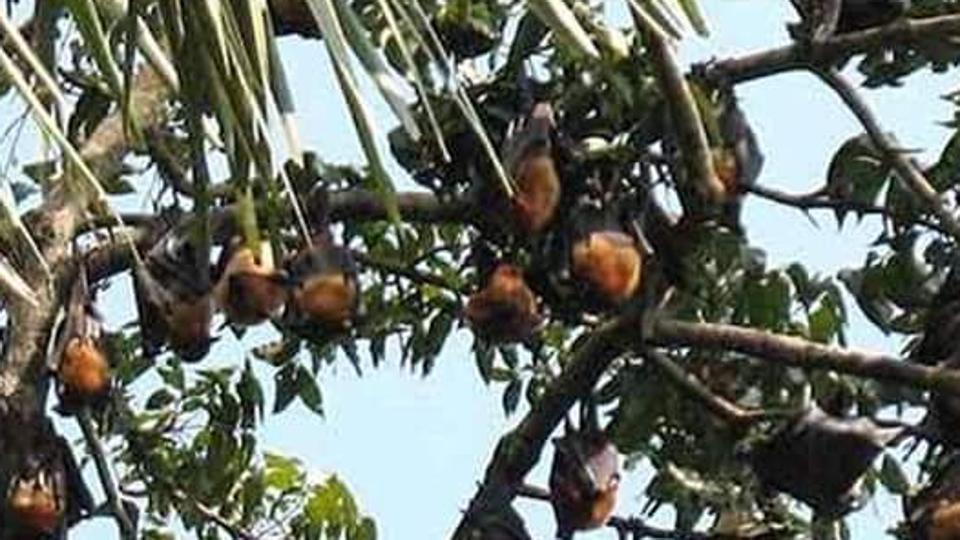
Fourteen deaths from Nipah virus infection in Kerala have fuelled unprecedented fear of bats, which were initially believed to be the source of the human infection, that led to scores of families abandoning their homes and livestock in the affected Kozhikode and Malappuram districts.
Lab tests, however later, showed that public health experts had got it wrong.
Fruit bats are natural hosts of the NiV virus of the Henipavirus genus of Paramyxoviridae family, from where the virus in the past has been known to jump pigs and humans in Malaysia, and to humans in Bangladesh and India, fluid and blood samples from the bats found from the well of the family that reported the first infections and four deaths in Changaroth village in Perambra in Kozhikode district tested negative for NiV.
The tests were done at India’s apex animal testing laboratory in Bhopal, which is one of India’s three biosafety-level 4 (BSL-4) labs with maximum biosafety containment measures to study infective agents that are highly contagious, potentially fatal and for which there are no available vaccines or treatments. The High Security Animal Diseases Laboratory in Bhopal focuses exclusively with zoonotic organisms and emerging diseases threats, while the Centre for Cellular and Molecular Biology in Hyderabad and the Microbial Containment Complex in Pune are BSL-4 containment labs to study human infectious diseases.
With the Bhopal lab on Friday declaring that 21 bats and domesticated animals from the affected families in Perambra were free of NiV, the Kerala state health department is scrambling to trace the source of the deadly infection, including taking a closer look at the travel history of Mohamed Sabith, 26, who arrived from Saudi Arabia and was the first to die of NiV infection in Kerala.
Viral hosts
The vindication will hopefully end the phobic culling of bats, which are found widely across India. Earlier this week, dead bats in a school compound in Himachal Pradesh led to parents keeping their children home from school. The bats, however, also tested negative for NiV.
Several species of fruit bats are found across India, of which Pteropus giganteus (greater Indian flying fox), Eonycteris spelaea, Cynopterus, Scotophilus kuhlii and Hipposideros larvatus are known to have NiV. In Delhi, the flying fox can be spotted on the many Indian fig and Jamun (acai berry) trees that line Akbar road and other avenues in Lutyen’s zone.
Bats are the primary reservoir for many viruses that cause deadly zoonotic diseases, but outbreaks are rare and can be quickly contained. Of the 188 known zoonotic viruses found in humans and at least one other mammal, bats host a higher proportion of zoonoses than other mammals, according to a study in Nature. Researchers estimated that there are about 17 zoonoses yet to be discovered in every bat species versus about 10 for rodent and primate species.
Infections happen because of ecological conflicts such as shrinking natural habitat and humans hunting bats, which lead to the virus in urine and saliva of stressed bats contaminating the environment. Among the most deadly human outbreaks from bat viruses are coronaviruses that caused the MERS-CoV and SARS-CoV outbreaks, Lassa haemorrhagic illness, Hantaviruses, Henipavirus fever from Hendra and the Nipah viruses, and haemorhagic fever from infections from Ebola and Marburg viruses.
Friends, not foes
Fruit bats in India have adapted to shrinking forests and unreliable food sources by turning nomadic, flying thousands of kilometres within days. Their relatively large furry body make them more efficient seed dispersers and pollinators than birds and bees, which operate in smaller areas. Flying foxes can carry pollen for up to 100 km in one night.
Far from being adversaries, bats help farmers. Bat droppings are rich in medium- to fast-releasing nitrogen, phosphorus and potassium, which are organic fertilisers. Insectivore species lower pesticide dependence. When insectivore bats Hipposidoros fulves fulves were driven out of the Ajanta and Ellora caves for fear thay might damage the paintings, farmers faced huge crop losses, which stopped when the bats returned.
While there are no studies for India, agricultural losses from loss of bats in North America were estimated at more than $3.7 billion per year in 2010, according to a study published in Science magazine.
Bats have many useful roles, from pollination to controlling insects and other pests. The transfer of viruses is extremely rare, so there is no reason to fear or fight them. Viruses emerge only if people make contact with bats and hunt them.
[“source=hindustantimes”]







